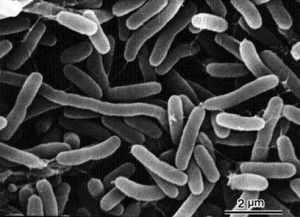Eating raw and cold shellfish can be such enjoyment under the hot sun. Living in BC makes us have the advantaged access to fresh and tasty shellfish. However, sometimes such delicacy comes with ricks and the major ones are the toxins produced by other organisms that live with shellfish.

According to Health Canada, Vibrios are toxin-producing bacteria that can be found naturally in water, fish and shellfish. Its main transmission is through consuming contaminated foods and drinks. Most of the pathogenic Vibrios are salt-loving, which means they live in oceans. For example, Vibrio parahaemolytius that caused an outbreak in Canada in the past summer.
During May to September 2015, 82 cases of Vibrio parahaemolytius were reported (60 of them were in BC) to Public Health Agency of Canada. All cases were related to consuming raw shellfish especially oysters. Due to this outbreak, oysters harvested from British Columbia coastal waters for raw consumption on or before August 18, 2015 were recalled from the marketplace.
In response to the the outbreak, Vancouver Coastal Health issued a statement on August 2, 2015 requiring restaurants to serve oysters after cooking as only oyster harvested from BC could be served raw at that time. Fortunately, this outbreak ended fast and well. The latest case was reported on September 3 and only one person was hospitalized. No death case was reported.
Symptoms:
People infected by Vibrio parahaemolyticus usually get mild intestinal illness. After 12 to 24 hours of incubation, most people develop one or more of the following symptoms: diarrhea (watery), stomach cramps, nausea, vomiting, fever and headache. Another pathogenic type of Vibrios, V. vulnificus can cause chills, abnormal low blood pressure and bacteria present in blood to infected individuals especially to the vulnerable. Symptoms last about three days and treatments are seldom required.
More sever than two types above, people infected by V. cholerae usually develop one or more of the following symptoms after one to three days of incubation: diarrhea (watery), leg cramps, vomiting, dehydration and low blood pressure. Due to the rapid loss of body fluid, treatment (re-hydration with fluid containing electrolytes) or antibiotics in serious cases is required.

Prevention:
1. Boil shellfish in shell until open and continue boiling for 5 minutes
2. Steam until shellfish open and continue steaming for 9 minutes
3. Do not eat shellfish that is not open
4. Boil shucked shellfish for 3 minutes or fry them in oil for >10 minutes at 375°F (190°C)
5. Drink water from reliable sources
There is a video on youtube that gives a brief intro of Vibrios, check this out if you are interested:
Sources:
http://www.phac-aspc.gc.ca/phn-asp/2015/vibrioparahaemolyticus-eng.php
31 Vibrio Cases Prompt BC Health Officials to Require Cooking of BC Oysters
http://www.bccdc.ca/dis-cond/a-z/_v/Vibrio/default.htm
http://www.healthlinkbc.ca/healthtopics/content.asp?hwid=ug2972
http://healthycanadians.gc.ca/eating-nutrition/risks-recalls-rappels-risques/poisoning-intoxication/poisoning-intoxication/index-eng.php
